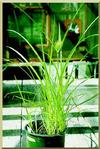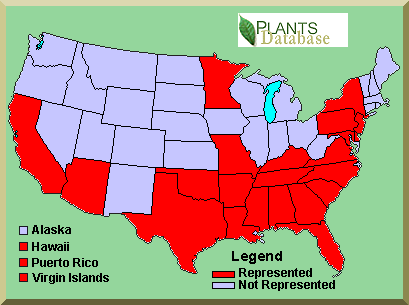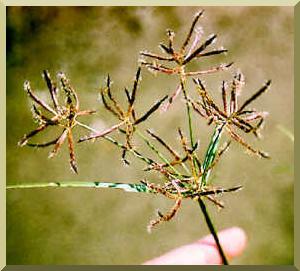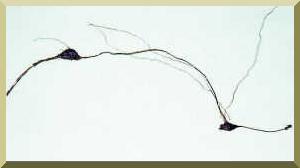|
|
|
|
| 3. PURPLE NUTSEDGE |
|
The native range of C. rotundus is Eurasia.
It is present in all southern states, in
most southwestern states, and in some northern states.
It is also present in the Pacific Islands, including Micronesia
and American Samoa, and elsewhere in Asia, including Australia, New Zealand,
Japan, Korea, Taiwan, China, Phillipines, Thailand, Cambodia,
Viet Nam, Malaysia, and Indonesia. It occurs elsewhere in the world in
regions with tropical to warm climates.
In Arizona, purple nutsedge is largely confined to the valleys; 100 to 4000 ft in elevation; flowering from May to fall frosts. It is present in all summer crops, in lawns, ditchbanks, and field borders. The rhizomes, runners, and tubers make the nutsedges almost impossible to erradicate. Purple nutsedge is reportedly native to India, but has been introduced around the World. The plant is a serious pest in the U.S. Southeast ranging from Virginia to Texas. It has become established in California and Arizona, and has the potential to invade other Pacific states.
Purple nutsedge occasionally occurs in more temperate regions, but it has not persisted in cold locales. The northern limit of nutsedge in Japan is in a region where the average minimum atmospheric temperature is -5oC, below which the tubers will not germinate. Temperature appears to limit the species to more tropical and warm temperate regions. Purple nutsedge is limited to areas where the average January temperature is above -1oC. |
|
3.1 Habitat Purple nutsedge is prevalent in disturbed areas and lawns. It grows best in moist, fertile soils; it does not grow well in shade, and once established, it is very persistent.
In California, purple nutsedge occurs in the Central valley, South Coast, and the Sonoran Desert, up to 250 m elevation. In Papua New Guinea it grows to at least 1800 m elevation. |
|
|
3.2 Characteristics Purple nutsedge closely resembles yellow nutsedge, but the matures stems are usually longer than the basal leaves. The leaves below the flowering heads, 1 to 5 inches long, are about the same length as the flower stems; few are longer. The spikelets are dark brown-purple, and the runners are fewer, woody, and thicker. The nutlets are oblong and covered by persistent reddish scales. Purple nutsedge is a colonial, herbaceous, perennial, with fibrous roots. It typically grows from 7-40 cm tall and reproduces extensively by rhizomes and tubers. The rhizomes are initially white and fleshy with scaly leaves, and become fibrous, wiry, and very dark brown with age.
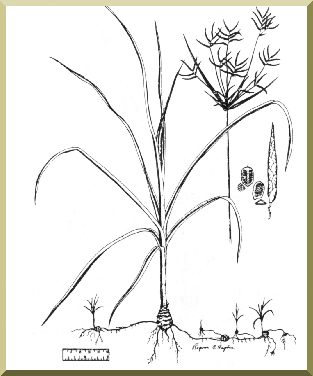
Rhizomes may grow in any direction in the soil. Those growing upward and reaching the soil surface become enlarged, forming a structure 2-25 mm in diameter variously called a "basal bulb, a tuberous bulb, or a corn" that produces shoots, roots, and other rhizomes. Rhizomes that grow downward or horizontally form individual tubers or chains of tubers. Individual tubers are dark reddish-brown when mature, about 12 mm thick, and 10-35 mm long. The dark green, shiny, three-ranked leaf blades arise from or near the base of the plant. They are narrow and grass-like ranging in size from 5-12 mm wide to 50-cm long and have a prominent channel cross section. The leaf sheets are tubular and membranous and attach to compact nodes at or near the base of the plant. The upright culms or stems are 10-50 cm tall, smooth, triangular in cross section, and support a much-branched inflorescence. Two to four leaf-like bracts subtend the inflorescence which is umble-like consisting of 3-9 unequal length branches (sometimes referred to as rays) bearing spikes of 3-10 spikelets. Spikelets are flattened and linear, ranging in length from 10-30 mm long and generally dark reddish purple or reddish brown in color. Each of the approximately twenty flowers (florets) in a spikelet is subtended by a keeled scale (glumes) 2-5 mm long, having a green midvein and membranous margin. The flowers are bisexual, each with three stamens and a pistil bearing three stigmas. Fruit, although rarely produced, consists of a three-angled achene (nutlet). The purple nutsedge is characterized by triangular, erect, solid, nodeless stems, each 12-18 inches in height; by basal leaves that are dark green and shorter than the stem; and by dark brown rhizomes that produce chains of irregularly shaped, hairy, dark brown to black tubers 1/4-1/2 inch in diameter. The rhizomes become like thin wires once the plant matures and serve to maintain dominance among tubers in that chain. The inflorescence is an umbrella-like cluster of branches 1/2-1 inch long and reddish brown to purple in color. Viable seed is produced, but the plant propagates almost exclusively by tubers. |
|
|
|
3.3 Growth and Development Rhizomes and tubers of purple nutsedge form extensive networks in the soil. While most tubers are found growing in the upper 15 to 20 cm, a few penetrate to a depth of 40 cm. The root system in heavy clay may extend more than 1-m deep. Under favorable conditions, a single tuber could produce 99 tubers in 90 days. Experimental planting of tubers set on 0.9-m centers resulted in their nearly five-fold increase by the end of the growing season. Tubers of purple nutsedge resist temperature extremes, but seem more sensitive to lower temperatures. Germination failed in tubers held for 12 hours at 50oC. However, greater than 80% germination occurred after exposure to 40oC. Tubers exposed to temperatures of -5oC did not survive more than 2 hours. Tubers and basal buds serve as vegetative propagules. They are carried on farm tillage implements and may be spread by erosion and running water. Severe storms may bring tubers to the surface and transport them to new areas. Such propagules may also be transported long distances with nursery stock. Even though purple nutsedge flowers abundantly, it rarely produces viable seeds. Seeds are disseminated by wind or water, transported in mud, or carried onto fields by flooding streams or with irrigation water. Purple nutsedge possesses the C4 photosynthetic apparatus, which is an adaptation to assimilating CO2 at higher temperature and higher light intensities compared to C3-pathway plants. C4 plants typically exhibit their best growth rates at temperatures characteristic of tropical and subtropical regions. The leaf anatomy for purple nutsedge is of the Krantz-type. Sheaths of cells that from around the vascular bundles serve to compartmentalize the photosynthetic events. 3.4 Reproduction Tubers and rhizome production are important factors in the purple nutsedge's success as a weed. Rhizomes provide the major means by which the plants may colonize an area. Tubers offer a mechanism for asexual reproduction, and they are the major dispersal unit capable of surviving extreme environmental conditions. Tubers make the plant difficult to control, because only translocated herbicides are potentially effective on this species. Besides their competition for resources, evidence suggests that organic substances released from the decay of dead subterranean tissues may be allelopathic and reduce crop yields where purple nutsedge infestations are severe. Purple nutsedge may produce up to 40,000 kg of subterranean plant material per hectare. Under experimental conditions, barley yield was reduced by 15 to 25% by C. rotundus residues in the soil. Tubers of purple nutsedge tolarate high temperatures, but not freezing. They germinate when soil temperatures remain above 15oC. Typically only one tuber in a chain germinates, unless the chain is severed. Low oxygen and high carbon dioxide levels appear to promote tuber dormancy. Tuber dormancy is high in undisturbed soils and deeper soil levels. Tubers can remain dormant for long periods and can become dormant after sprouting. Tuber dormancy often increases with age. New tubers are initiated when flowers develop, often about 4-8 weeks after shoots emerge. Tubers planted at a depth of 90 cm are usually unable to produce aerial shoots. Tubers desiccate quickly when detached from the rhizome-root system under dry conditions and can survive flooded soils for at least 200 days. Tuber longevity is variable and depends on environmental conditions. In most cases, tubers survive about 3-4 years, but under certain conditions, they can remain viable for up to 10 years or more. Seedling survival is typically low. Purple nutsedge has been called the world's worst weed. This is a befitting designation for a species known from more countries (at least 92) than any other weed and that infests at least 52 different crops worldwide. It grows in all types of soils and can survive with the highest temperature known in agriculture. In the United States, purple nutsedge infests cultivated fields, waste areas, roadsides, pastures, and natural areas. It is considered a headache for the Southern gardener because of its insidious, rapid growth in flowerbeds and vegetable gardens. Purple nutsedge produces an extensive system of underground tubers from which they can regenerate. Nutsedge is very difficult to control once it is established. Purple nutsedge greatly impacts agriculture and has an unfavorable effect on natural ecosystems by displacing native plants or by changing the availability of food or shelter for native animals. Although relatively small in nature, purple nutsedge provides formidable resource competition for much larger crop plants and ornamentals This rapid growing plant can quickly form dense colonies due to its ability to produce an extensive system of rhizomes and tubers. Many studies document reduced yields in sugar cane, corn, cotton, rice, vegetables, and numerous other crops. The abundantly produced tubers present an efficient means of dispersal and reproduction. These features, together with the ineffectiveness of herbicides, make this weed nearly indestructible.
3.5 Economic Importance
Cyperus rotundus, reportedly originating in China, is used as a carminative and energy and hormone regulating herb in Traditional Chinese medicine. Purple nutsedge has also been used in landscaping in China. There are reports of its use in India as a soil binder. It is undesirable as fodder, because it quickly becomes fibrous with age, but in the absence of more desirable plants, it can serve that purpose. Extracts and compounds from purple nutsedge have medicinal properties such as reduction of fever, inflammation, and pain. The literature contains numerous references to the use of the roots of this plant for essential oils and its seeds for food products. Tuber extracts may reduce nausea and act as a muscle relaxant. 3.6 Chemical Control There are no herbicides registered for use on all vegetables that will control purple nutsedge. While there herbicides that can be used safely to control purple nutsedge in lawns, these herbicides should not be used on vegetables, unless so specified on the label. Herbicides such as Image, Manage, or MSMA can be used to successfully control purple nutsedge in the lawn; however, these herbicides will severely injure or kill most vegatables or may result in herbicide residue in the produce. The chemical control of purple nutsedge is described in the following tables.
|
| Herbicides | Turfgrass | Ornamentals | Warm-season grasses | Cool-season grasses |
| Preemergence | None available | None available | None available | None available |
| Post-emergence | Basagran T/O, Daconate 6, Image | Basagran T/O, Roundup | Image, Daconate 6 | None available |
| Herbicides | Bermuda grass | Centipede grass | St. Augustine grass | Zoysia grass |
| Preemergence: None | N.A. | N.A. | N.A. | N.A. |
| Post-emergence: Halosulfuron | yes | yes | yes | yes |
| Post-emergence: Imazaquin | yes | yes | yes | yes |
| Post-emergence: Imazaquin + MSMA | yes | no | no | yes |
| General | Yellow Nutsedge | Comparison | Sustainable Control Strategies |
| Strategies for the Ojos Negros Valley | Summar | Coquillo Facts |
| http://ponce.sdsu.edu/three_issues_coquillofacts03.html | 021106 |
